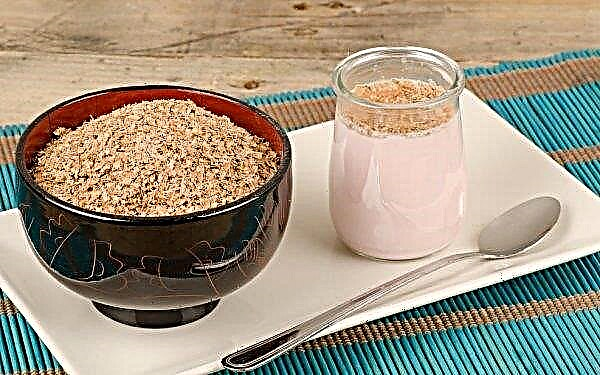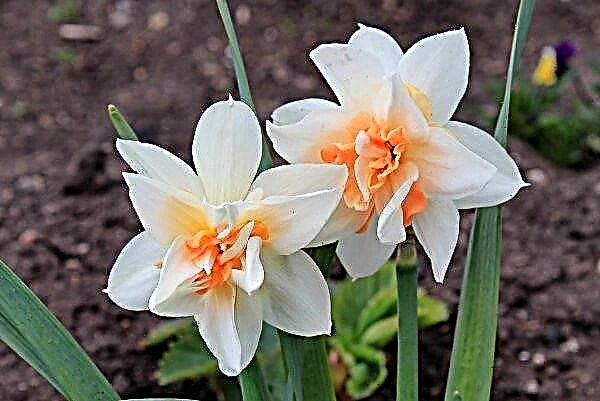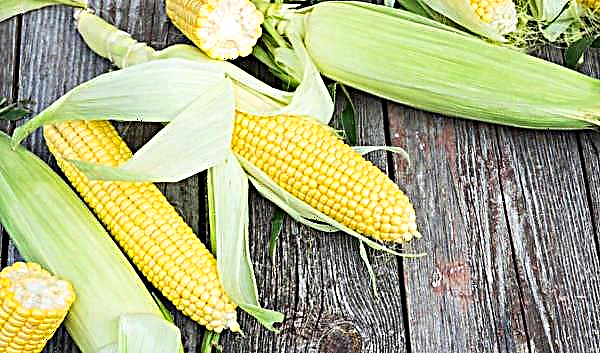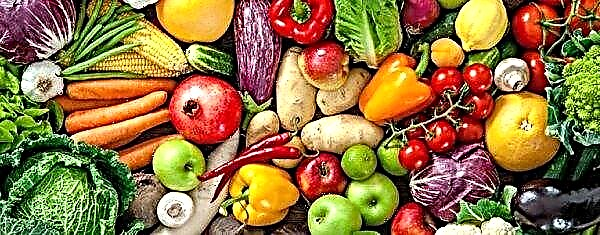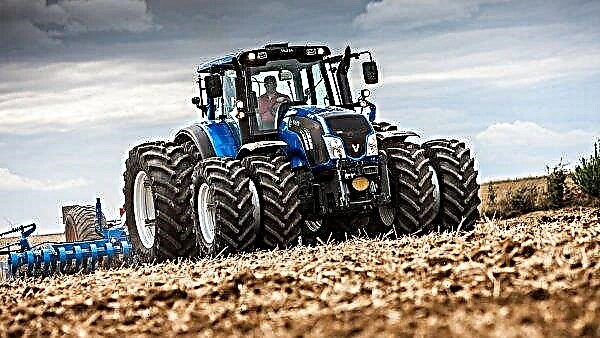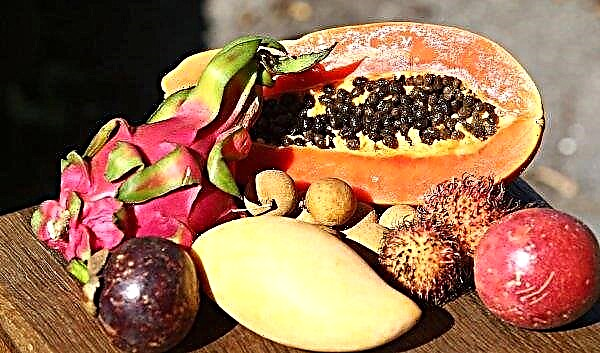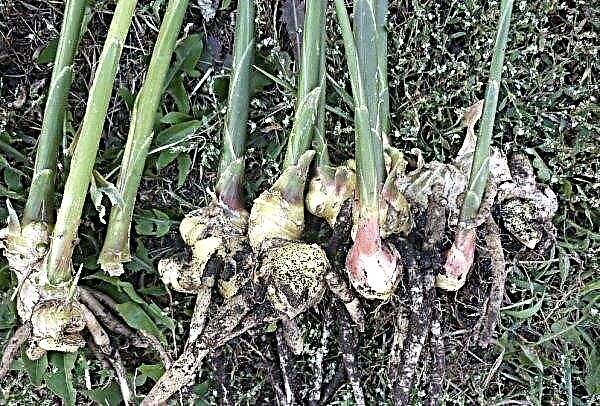Broccoli is a plant from the cabbage family, which is distinguished by the fact that not its leaves, but unopened inflorescences are eaten. This is a useful vegetable crop, containing many valuable elements and is characterized by the highest content of vitamin A among all cabbage. To have a tasty and nutritious vegetable on the table, you need to learn how to grow it properly. You will learn about how to grow and care for broccoli in the open field from this article.
The origin and description of the culture
Broccoli is one of the oldest vegetables grown by humans. In the wild, she did not grow. It was bred by hybridization in the northeast of the Mediterranean in the VI – V centuries. BC e. This vegetable plant, belonging to the cabbage family, forms a stem 60–90 cm high, on top of which peduncles with small green buds are formed.
Did you know? A lover of growing giant vegetables from America, John Evans managed to get some of the largest types of cabbage in the world. White-skinned weighed 34.4 kg, broccoli - 15.8 kg, Brussels - 14.1 kg.
It is the unripe, unopened buds that are eaten. This variety of cabbage is appreciated because of its rich chemical composition and the beneficial effects that it can exert on the human body. Breeders bred more than 200 varieties of broccoli.
Today broccoli has 3 varieties:
- Classical or Calabrian.

- Red, similar in appearance to cauliflower.

- Stem.
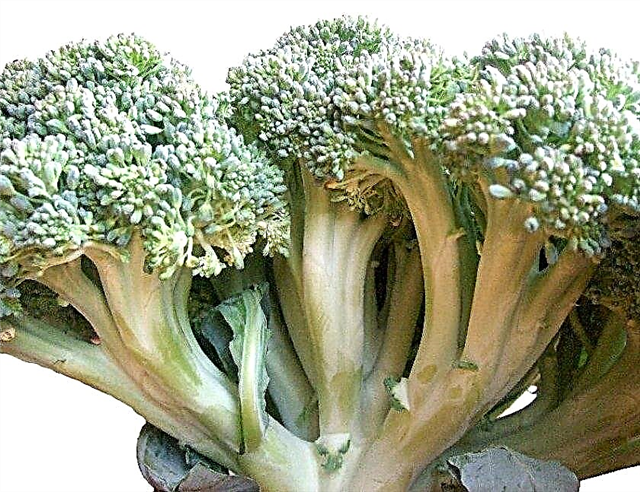
Optimal growing time
The best way to plant broccoli is through seedlings. Seeds should be planted in the first half of March. In this case, planting seedlings in the ground can be done in mid-May, and harvesting in the phase of technical maturation in August-September. In warm regions, it is possible to sow seeds directly into the ground. Do it at the end of April. Seeds are placed in greenhouse soil from late March to early April.
For regions with short and cold summers, mid-ripening and early ripening varieties are selected. To extend the yield period and for a long time to have fresh broccoli on the table, you can combine seedlings and seedlings. For example, to plant seedlings in early May, and to sow seeds from the end of spring to the beginning of summer every 2 weeks.
Important! Purchased soil does not need disinfection. Mandatory etching is subject to do-it-yourself soil. It is kept in the oven, over steam, in the microwave, watered with boiling water or potassium permanganate.
Broccoli Growing Technology
Growing in a seedling-less way must begin with the acquisition of tanks, the preparation of seed and soil substrate.
Seed preparation
In order to grow good seedlings, it is necessary to properly prepare the seed.
Before sowing, the following manipulations should be performed:
- Select the largest seeds.
- Maintain them for a quarter of an hour in water at a temperature of + 50 ° C.
- Dip for several minutes in cold water.
- Put in a solution of "Epina" or another growth stimulator for better germination for 12-15 hours.
- Rinse under running water.
- Put on the bottom shelf of the refrigerator for 24 hours.
- Dry well.

Soil preparation and selection of containers for seedlings
For growing seedlings, a long box with a depth of 25 cm made of wood or plastic is suitable. Drain should be placed on its bottom. Soil for seedlings can be purchased at a specialized store or made by hand, mixing 2 parts of turf land, 1 part humus and sand and 0.5 parts wood ash. It should be loose, with good moisture and soil conductivity, with neutral or slightly alkaline acidity. Before sowing, the soil must be well moistened.
Sowing Broccoli Seeds
The technology of sowing seeds is as follows:
- In moist soil, make grooves with a depth of 1-1.5 cm, observing gaps of 3 cm.
- Deepen the seeds into the grooves.
- Sprinkle with soil.
- Seal a little.
- Send the tank to a room with a temperature of + 19 ... + 20 ° С.
Video: sowing broccoli cabbage
Seedling care
Shoots should appear throughout the week. For their proper development, it is important to maintain the correct temperature and produce quality care. After hatching seedlings, it is necessary to lower the temperature to + 10 ° C. This regimen should be maintained for 7 days.
In the future, the temperature is slightly increased: on sunny days - up to + 16 ° С, on cloudy days - up to + 14 ° С. At night, the temperature can be kept at +9 ... + 10 ° С. Humidity of air and soil must be maintained at a high level. Soil should be moistened with a spray gun.
At the age of 14 days, it is worth picking the sprouts. In the future, they need to be grown in separate containers - peat pots or plastic cups, at a temperature of + 21 ° C. At first, shelter from sunlight is required.
Did you know? Broccoli are considered negative-calorie foods. This means that the body spends more calories on its digestion than it receives when it enters the digestive tract.
Caring for plants after a dive involves regular moisturizing, feeding and hardening. As soon as they depart from the transplant procedure and start growing, they must be fed with full mineral fertilizer, which must include molybdenum and boron. During the day, the temperature should be maintained at + 17 ° C, at night - + 9 ° C.
14 days before the intended planting in a permanent place should begin to harden the plants. First, the sprouts are kept for a couple of days with the window open, then they are taken out to fresh air, starting from 40 minutes a day, gradually increasing the length of stay.
Preparation of a plot for planting seedlings
It is necessary to prepare beds for broccoli in the fall. They are thoroughly cleaned of plant residues, well digged and fertilized with manure or compost at the rate of 4-5 kg / 1 m². If necessary, reduce acidity by adding lime.
Transplanting
Sprouts are transferred to open ground when they reach the age of 30-50 days. However, the readiness of seedlings for planting in the garden is determined not only by its age - you must know how it should look.
Sprouts that have the following characteristics are ready to move to a permanent place:
- strong stems;
- well developed root system;
- the presence of 5-6 true leaflets.
The temperature on the street during the landing should be warm, and the threat of night frosts should be passed. To grow cabbage, you must choose a well-lit area, closed from drafts. The culture is not too demanding on the composition of the soil, can grow on almost anyone that has a slightly alkaline or neutral acidity level.
Important! Planting seedlings in the garden should be carried out only in cloudy, dry weather or in the evening, after the sun sets.
When choosing a site for planting, attention should be paid to crop rotation recommendations. It is best to plant cabbage after siderata, carrots, onions, grains, cucumbers, potatoes. Bad predecessors for broccoli are all members of the cabbage family, tomatoes, beets, radishes, turnips, radishes.
The technology of planting seedlings is as follows:
- Make holes according to the scheme 35 × 60 cm.
- In each pit, place complex mineral fertilizer (5-10 g), mixing it with soil.
- Install a germ in the center of the hole.
- Fill the hole with soil.
- Seal up.
- Water abundantly.
- Cover the planting with a film (in case of a threat of frost). Seedlings are afraid of frosts below –2 ° С.
- At first, shade from scorching sunlight by coniferous spruce branches or agrofibre.
Video: planting broccoli seedlings in the open ground
Care Features
After planting cabbage in the ground, it is necessary to allocate time in order to moisturize it, feed it with fertilizers, take care of the soil, spud and treat it with folk remedies or chemical preparations in order to prevent the development of diseases and the attack of harmful insects.
Watering Rules
If the summer is not too hot in the summer and the thermometer does not rise above + 25 ° C, then 1 humidification per week is enough for broccoli. At hotter temperatures, the amount of watering should be increased. Cabbage is watered under the root, trying to avoid getting drops on the leaves and inflorescences. On hot days it is good to spray air over the beds. Do this only in the evening. Watering should be plentiful so that the soil is moistened to a depth of 12-15 cm.
Fertilizer application
Good heads go out in case of regular top dressing. Broccoli is recommended to be fed 3-4 times per season.
To schedule fertilizer application, you can use the following recommendations:
| Application Period | Fertilizer Options |
| 14 days after planting seedlings on beds | Mullein (1 tbsp. / 1 bucket of water) + urea (1 tsp.) Chicken droppings (1 to 20 with water) |
| 14-21 days after the first feeding | Ammonium nitrate (1 matchbox / 10 l of water) |
| During the formation of inflorescences | Superphosphate (40 g) + ammonium nitrate (20 g) + potassium sulfate (10 g) + water (10 l) |
Broccoli also responds well to the application of green fertilizers (infusions from comfrey, nettle), wood ash (1 tbsp. / 1 m²).
Weeding and cultivation
In order to prevent the formation of a hard crust on the surface of the soil, as well as to improve its air and moisture permeability, a day later, after each moistening or precipitation, the soil must be loosened. Loosening of cabbage is carried out to a depth of 8 cm.
Important! Broccoli heads ripen at temperatures up to + 18 ° С. In hotter conditions, it is absent. Therefore, it is important to adhere to the recommended planting dates, especially late varieties.
Hilling
Hilling is done twice a season: the first time - 20 days after planting in the beds, the second - 10 days after the first procedure. Sapa or rake the soil sprinkled with a hill 30 cm high to the stem, pulling it from a distance of 25 cm. Hilling allows you to prevent the development of the black leg, to avoid colonization of the cabbage fly, to strengthen the root system.
Disease and Pest Prevention
If you ignore the recommendations for planting and care, take care of the plants irregularly, then there is a high risk that they will be sick and affected by harmful insects. Of the pests, a great danger to young cabbage is cruciferous flea. To prevent damage to plants by this insect, the beds are covered with a non-woven fabric. 20 days before flowering, spraying with insecticides is used. After flowering, they resort to dusting with a mixture of wood ash with tobacco dust or spraying with an aqueous ash solution. Of the pests, cabbage can also attack aphids, cabbage fly, larvae of butterfly cabbage, slugs. To avoid attacks aphids it is necessary to destroy nearby anthills in time, to carry out loosening and weeding in a timely manner, to use mixed plantings, planting plants from the umbelliferous family in the aisles. Cabbage fly you can not let the beds with regular soil care, planting marigolds nearby, marigold, dill, surrounding each plant with cardboard circles.
Of the pests, cabbage can also attack aphids, cabbage fly, larvae of butterfly cabbage, slugs. To avoid attacks aphids it is necessary to destroy nearby anthills in time, to carry out loosening and weeding in a timely manner, to use mixed plantings, planting plants from the umbelliferous family in the aisles. Cabbage fly you can not let the beds with regular soil care, planting marigolds nearby, marigold, dill, surrounding each plant with cardboard circles.
Butterfly cabbage expelled from the site by spraying with infusions of valerian, needles, potato, tomato tops, a soap solution with ash. Slug Do not settle in bright, well-cleaned areas. Therefore, it is important to timely clean the beds, remove the lower leaves, weeds. Around the cabbage, you can make holes in which every 2 weeks pour ash with tobacco dust.
Important! If you store broccoli in room conditions, then after only a couple of days the content of ascorbic acid in it decreases by 2 times.
Often summer residents are faced with problems when growing broccoli. For example, many are interested in questions of why the plant does not form heads; inflorescences are not tied to it. There may be several reasons for this: the lack of removal of stepchildren, the wrong time for planting seedlings in the ground, lack of moisture against the background of too hot summers, or the absence or excess of fertilizing.
To avoid the occurrence of a problem, it is necessary to avoid all of the above errors. When forming the head, it should be hidden in bound leaves to protect it from harmful sunlight and allow it to develop well.
Among the dangerous diseases of broccoli should be called alternariosis, peronosporosis, mosaic, black leg. In order to prevent them, it is necessary not to thicken the plantings, timely tear off the lower leaves, inspect plants daily, observe the recommendations on agricultural technology and crop rotation.
Harvesting and storage rules
To understand when the cabbage is ready for harvesting, you need to know what a ripe and overgrown vegetable crop looks like. You need to remove the heads in the phase of technical maturity - with green inflorescences. At this time, the head reaches a size of 10 to 17 cm. In an overripe vegetable, the inflorescences will be yellow. Such a head of cabbage is already unsuitable for food.
Cabbage is harvested by cutting the central stem with a sharp knife when it reaches a height of 10 cm. Later on, as the ripening stems are cut off on the side shoots. Harvesting is started in the early morning. When harvested under the sun, the heads will quickly fade.
Early varieties must be consumed for 2 weeks after harvest or placed in a freezer. Late cabbage can be stored for a longer period - 2-3 months. When cleaning in October, it is placed in a refrigerator or a cellar with zero temperature and humidity of 90–95%. Only a healthy-looking cabbage is sent for storage, which has no damage, signs of rot and fungal infection. You can extend the shelf life of broccoli in the refrigerator if you place it in a plastic bag that you don’t close. In frozen form, the vegetable crop will be suitable for use throughout the year. Now you know how broccoli grows and how to grow it properly, for example, in the country. This process is simple. The main thing is to adhere to competent agricultural technology and not to neglect the recommendations for care.
You can extend the shelf life of broccoli in the refrigerator if you place it in a plastic bag that you don’t close. In frozen form, the vegetable crop will be suitable for use throughout the year. Now you know how broccoli grows and how to grow it properly, for example, in the country. This process is simple. The main thing is to adhere to competent agricultural technology and not to neglect the recommendations for care.




